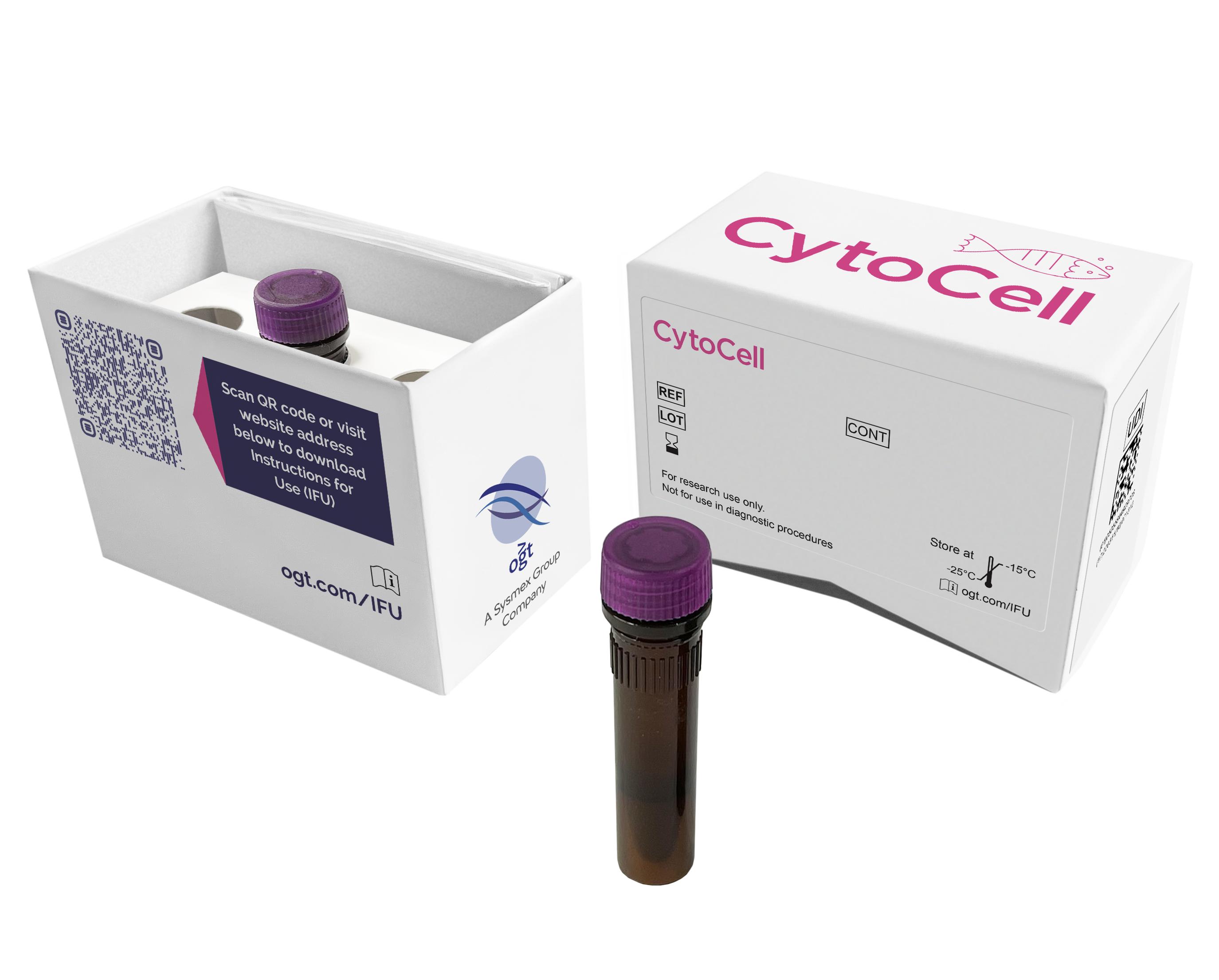
The AML1 component consists of a 156kb probe, labelled in red, located centromeric to the AML1 (RUNX1) gene that spans the CLIC6 gene and a 169kb probe covering part of the AML1 (RUNX1) gene, including markers SHGC-87606 and D21S1921. The ETO (RUNX1T1) component, labelled in green, consists of a 151kb probe covering the centromeric part of the gene and the flanking region and a 194kb probe covering the telomeric part of the gene and the flanking region.
The RUNX1 (RUNX family transcription factor 1) gene at 21q22.1 is fused with the RUNX1T1 (RUNX1 partner transcriptional co-repressor 1) gene at Ensembl location 8q21.3, in the t(8;21)(q21.3;q22.1) translocation, found most commonly in patients with acute myeloid leukaemia (AML) FAB (French-American-British classification) type M2.
AML with a RUNX1::RUNX1T1 fusion resulting from a t(8;21)(q21.3;q22.1) translocation is a recognised disease entity according to the World Health Organization (WHO) classification of myeloid neoplasms and acute leukemia1. The translocation is observed in 10%-22% of patients with AML FAB type M2 and 5%-10% of AML cases overall, most commonly in children and young adults2 and is a good prognostic indicator3,4,5. The t(8;21) breakpoint mainly occurs in the intron between exons 5 and 6 just before the transactivation domain and fusion protein created contains the DNA-binding domain of RUNX1 fused to the transcription factor RUNX1T12.
In addition to the reciprocal t(8;21) translocation creating the RUNX1::RUNX1T1 fusion, variant translocations have also been reported. These variant rearrangements may be cryptic and easily overlooked by G-banding; however, FISH can indicate the presence of such rearrangements2.
The CytoCell® AML1/ETO (RUNX1/RUNX1T1) Translocation, Dual Fusion Probe is a qualitative, non-automated, fluorescence in situ hybridisation (FISH) test used to detect chromosomal rearrangements between the 21q22.1 region on chromosome 21 and the 8q21.3 region on chromosome 8 in Carnoy’s solution (3:1 methanol/acetic acid) fixed haematologically-derived cell suspensions from patients with confirmed or suspected acute myeloid leukaemia (AML).
This device is designed as an adjunct to other clinical and histopathological tests in recognised diagnostic and clinical care pathways, where knowledge of AML1::ETO (RUNX1::RUNX1T1) translocation status would be important for clinical management.
This device is designed to detect rearrangements with breakpoints in the region covered by the red and green clones in this probe set, which includes the AML1 and ETO (RUNX1 and RUNX1T1) regions. Breakpoints outside this region, or variant rearrangements wholly contained within this region, may not be detected with this device.
This device is not intended for: use as a stand-alone diagnostic, use as a companion diagnostic, prenatal testing, population-based screening, near-patient testing, or self-testing.
This device has not been validated for sample types, disease types, or purposes outside of those stated in the intended purpose.
It is intended as an adjunct to other diagnostic laboratory tests and therapeutic action should not be initiated on the basis of the FISH result alone.
Reporting and interpretation of FISH results should be performed by suitably qualified staff, consistent with professional standards of practice, and should take into consideration other relevant test results, clinical and diagnostic information.
This device is intended for laboratory professional use only.
Failure to adhere to the protocol may affect the performance and lead to false positive/negative results.
Find certificate of analysis documentation for our CytoCell FISH probes

Our lab has been using a wide range of CytoCell FISH probes for a number of years, and have been increasing this range all the time. The probes have clear bright signals and show good reproducibility. CytoCell provides fast delivery of catalogue probes, and are very responsive when we have any queries or problems with their products.

Bridget Manasse
Addenbrookes Hospital, Cambridge University Hosiptals NHS Foundation Trust, UK
In our hands, CytoCell FISH probes have proven to be of the highest quality with bright, easy to interpret signals, thus providing confidence in our results. OGT's customer support is outstanding, as their staff are extremely knowledgeable and truly care about their customers and their customers’ needs.

Jennie Thurston
Director of Cytogenetics, Carolinas Pathology Group, USA
I first came across CytoCell FISH probes in a previous lab I worked in and I was struck by the quality of the products. Since this time, I have been recommending and introducing CytoCell probes across all application areas — now they are the primary FISH probes used in our lab. They have an excellent range of products and their ready-to-use reagent format saves considerable time.

Elizabeth Benner
Medical Technologist, University of Arizona Health Network, USA
We have been working with CytoCell fish probes for two decades because of their excellent clarity and intensity regardless of the size of the probe. It is so clear and simple to detect.
Dr. Marina Djurisic
Head of Laboratory of Medical Genetics, Mother and Child Health Care Institute of Serbia “Dr Vukan Cupic”, Serbia
The quality and consistency of CytoCell’s probes means I can trust the results, and my clients get their results in a timely manner.

Dr. Theresa C. Brown
Director, Cytogenetics Laboratory, Hayward Genetics Center, Tulane University School of Medicine, USA
It was very important for us to have more consistent results with our probes — easy-to-read bright signals and a range of vial sizes, which is much more cost-effective.

Janet Cowan, PhD
Director of the Cytogenetics Laboratory, Tufts Medical Center, USA
Not only do CytoCell offer an extensive range of high-quality FISH probes, the customer support is also excellent — providing fast access to all the probes I need. The probes are highly consistent with bright signals allowing easy scoring of results.
Dr. Eric Crawford
Senior Director, Genetics Associates Inc., USA
The quality and reproducibility of results using the CytoCell kit has been vital in accurately detecting co-deletions in our glioma investigations. We now have a cost-effective test that we can rely on that is also easy to use and interpret. We've been consistently impressed with this kit - not to mention the support offered by OGT's customer service, and have completely transitioned over to CytoCell probes.
Gavin Cuthbert, FRCPath
Head of Cancer Cytogenetics, Northern Genetics Servce, Newcastle, UK